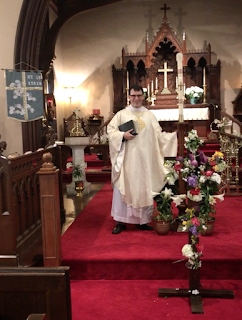Revelation 7:9-17 speaks of the saints who "have washed their robes and made them white in the blood of the Lamb."
Each Sunday, we get a reminder of those robes by those we see wearing an alb. Here is an example of me wearing an alb in the photo below from my ordination to the diaconate on 14 May 2016:
Albs can be worn by anyone ministering in the Eucharist, lay or ordained. They are a reminder of our baptism, when we are washed "in the blood of the Lamb." The gowns that those of us who were baptized as infants worn and the white pall placed over casket at a funeral are related to and meant to remind us of the alb. The alb itself is a reminder of who we are as God's people.
In some churches, you'll also see ministers in the Eucharist service (generally in the choir, but sometimes acolytes or even clergy as well) wearing cassock and surplice. Here is a photo of two of my friends and colleges wearing a cassock, white surplice, and a stole at my ordination to the order of priests on 12 November 2016. I am in the middle with alb and stole:
The surplice is an offspring of the alb itself, so it too is a reminder of our status as washed in Christ's blood.
The alb itself dates back to the time of the early Christians where Romans wore robes. They also wore stoles as a mark of their office. Here is a picture of a stole on it's own, without the alb:
When you see someone in a stole, it is a sign they are ordained. If it is over the shoulder, the person is a deacon. Straight down, the person is a priest. Use this photo once again as a reference:
Finally, Romans had an outer garment that has become what we call a chasuble. It fits over the alb and stole a little like a poncho, as you can see here:
as well as here:
Chasubles signifies the person wearing it is the celebrant, or presider, for the Eucharist.
Some will put the chasuble on after the Liturgy of the Word and right before the Eucharistic Prayer. I personally do not because the Eucharist isn't separated into parts, but instead is one united liturgy.
We wear the chasuble and other vestments not because the Eucharist cannot happen without them, but because we are putting on our finest clothes for a feast. Every Sunday is a feast of the resurrection because ever Sunday we are reminded of Jesus' death and resurrection by the very act of celebrating Holy Eucharist together.
Also, by wearing these vestments, we recall in our minds the early Christians and all other Christians that have followed and worn these same vestments since. We worship in solidarity with the church throughout the ages. And just as the words of the Eucharist make the events of the past present to us in a real and mysterious way (see Faith Fact on "remembrance" in the Eucharist), our vestments also make us present with all Christians throughout time and space who celebrate the Eucharist together as one.
Vestments, apart from the alb, do not have any special meaning aside from the fact that they were how the early Christians would have dressed in the Roman Empire. But that is all the meaning they need. They remind us of how Christians worshiped and gave thanks in the past, and they are a reminder that the church is still, and will continue to be, in relationship with the One True and Living God through our Lord and Savior Jesus Christ for all of time.
Resources:
Grisbrooke, W. Jardine. "Vestments". Cheslyn Jones et al. eds. The Study of Liturgy: revised edition. New York: Oxford University Press, 1992.
Malloy, Patrick. Celebrating the Eucharist. New York: Church Publishing, 2007.





